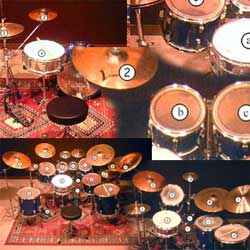
 : : : Lessons : : Conceiving your drum set : Introduction:
: : : Lessons : : Conceiving your drum set : Introduction:
INTRODUCTION :
This lesson aims to help every drummer to create a custom set, which is almost a unique specificity of the musical instrument called "drumset" (which is actually an assembly of different instruments and even different families of instruments).
 I present here ten different sets with photos in subjective view (at the place of the drummer) and description of each instrument constituting the set, technical explanations on the interest of each arrangement and finally, historical references (date of appearance of the first sets of this kind, famous and virtuoso drummers who used it more or less except for few sizes or instruments (some drummers have considerably modified their sets during their career), playing style and of the music generally associated).
I present here ten different sets with photos in subjective view (at the place of the drummer) and description of each instrument constituting the set, technical explanations on the interest of each arrangement and finally, historical references (date of appearance of the first sets of this kind, famous and virtuoso drummers who used it more or less except for few sizes or instruments (some drummers have considerably modified their sets during their career), playing style and of the music generally associated).
As I've already said in the historical description of the drumset, at the origin, each instrument of the drumset was played by a single player. The “modern drummer” (playing a “modern” drumset), as for him, plays necessarily on several instruments at the same time, initially mimicking the style of the military drumming ("one man-band", often with guitar and harmonica also tied to the neck, for the first, a few centuries ago, in Europe already). On the other hand, there is no limitation of this set (kit or instrumentarium) except perhaps the imagination or size of the arms! Some drummers like Terry Bozzio, who plays in solo, gather together more than twenty drums, almost ten pedals, and about forty cymbals (it is a historical record).
The sets presented here are classified in increasing order of amount of instruments. You will see also that it does not always follow the historical chronology, contrary to what one might naively think.
Finally, I emphasize, in the preamble, the fact that there are no rules in art (this is specific to this discipline) and that on the opposite, a real artist has to be as creative as possible. The realization of a set is a significant opportunity for any drummer to express this creative ability. Most of the great drummers in history had an original set that was largely copied or became a kind of mark of sound recognition, regardless of their own playing.
- Notation key:
- Arabic numerals: cymbals
- Roman numerals: bells and woodblocks
- Small letters: drums (toms, snare, bass drum, rototoms, timbales, etc.).
- Capital letters: special pedals and their extension (double, bell stand, etc.).
Sizes (diameter or depth for snare drums) are designated in inches (U.S. measure) symbol:'' one inch = 2.54 cm.
NB: the sizes of the instruments of the photo may sometimes vary slightly from the size specifications, because of lack of means. The specifications indicates the standard or medium sizes for this type of drumset.
- Set 1 : Swing, funk
- Set 2 : New Orleans, klezmer
- Set 3 : Be bop, pop
- Set 4 : Standard rock , free jazz
- Set 5 : Big band, hard rock
- Set 6 : Fusion
- Set 7 : Metal, free groove
- Set 8 : Fusion, metal
- Set 9 : Metal, progressive rock
- Set 10 : Latin, metal
Marc De Douvan, march 2006, augmentation and translation in English: march 2015.
© 2005 Marc de Douvan Crédits Mentions légales
